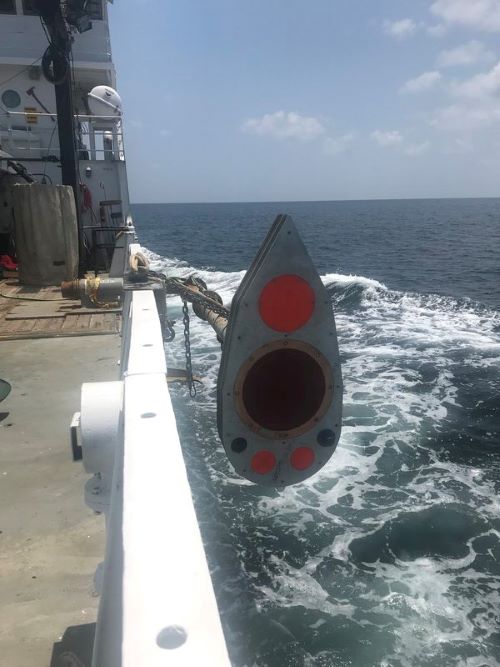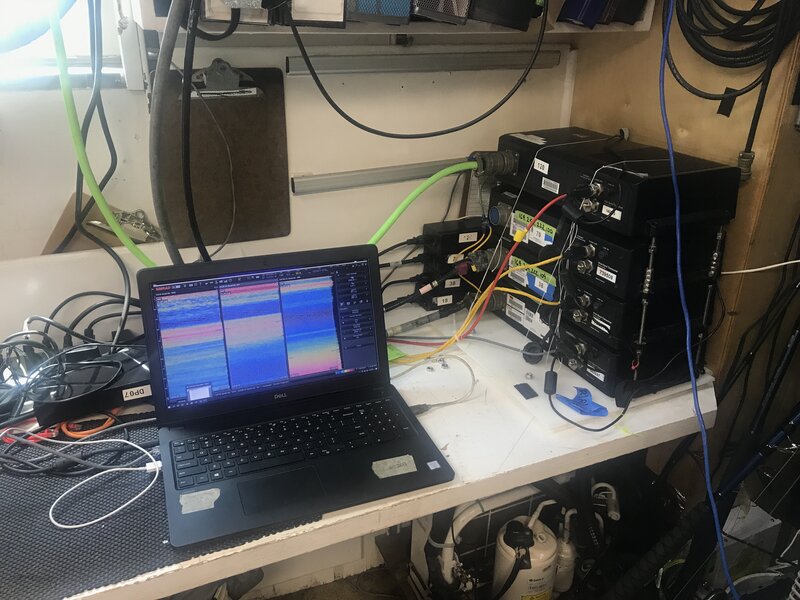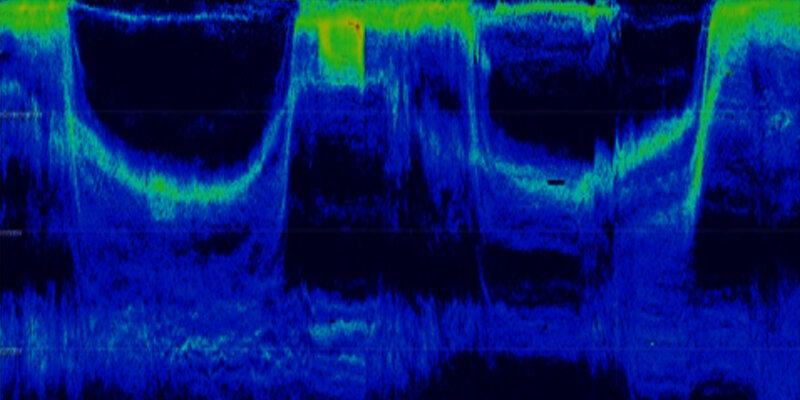
By Chris Taylor, Senior Scientist, NOAA National Centers for Coastal Ocean Science, Marine Spatial Ecology Division
Echosounders have been employed in fisheries and ocean research for decades to detect fish, plankton, and features both on the seabed and in the water column. The ship-mounted echosounder on the R/V Point Sur will provide the first line of evidence for the location, depth, and relative abundance of the mesopelagic community.

The transducer pod holds the four frequencies (18 kHz, 38 kHz, 70 kHz, and 120 kHz) of transducers, seen here as orange circles, that are used to sense mesopelagic communities from the ocean surface. Image courtesy of From Aggregations to Individuals: Exploring Migrating Deep-Sea Scattering Layers Through Multiscale-Multimode Technologies in the Gulf of Mexico. Download largest version (jpg, 2.0 MB).
This echosounder is a system of multiple transducers and transceivers that transmit sound through the water at frequencies from 18 kilohertz (kHz) to 120 kHz. Electrical pulses are generated by the transceiver and transmitted to the transducer, which vibrates and transmits those pulses, or sound, into the water. The sound that is reflected back vibrates the transducer, and is then sent to the transceiver, where the information is processed and can be viewed on a laptop as an echogram. For this mission, the transducers are mounted inside a pod at the bottom of a pole that is hanging over the starboard side of the ship.

This laptop, showing three echograms, is hooked up to the four transceivers (black boxes on the right hand side of the photo). Each transceiver is hooked up to its respective transducer, which is housed in the transducer pod pole-mounted to the ship. Together, the transceivers and transducers make up the echosounder. Image courtesy of From Aggregations to Individuals: Exploring Migrating Deep-Sea Scattering Layers Through Multiscale-Multimode Technologies in the Gulf of Mexico. Download largest version (jpg, 2.3 MB).
The energy from the higher frequencies (70 and 120 kHz) is absorbed by water quickly and only transmits a few hundred meters. The low frequency echosounders (38 and 18 kHz) can transmit sound through the full depth of our research area in the Gulf of Mexico (about 1,800 meters, or 5,250 feet). Acoustic reflection from the mesopelagic community will show up as layers in the water column, with complex structure and migrations occurring during day and night.
But remotely sensing the scattering layer from as far away as 1,000 meters (3,281 feet) has its limitations. Due to the length of the transmitted pulse and the spreading of the acoustic beam, the organisms in the scattering layer reflect sound as a collective mass, what we term “volume scattering.” We lack fine resolution images of the layers and cannot detect individuals to make inferences on their species-specific acoustic properties. We know the layers are diverse communities with each organism responding to various cues and migrating vertically. We will see this in real time from the ship, and use this information to guide the glider with the echosounder and the drift cameras to investigate the layers more closely, hopefully getting us to the species and individuals making these fascinating migrations through hundreds of meters of water in short hours.

Image from an echogram showing backscatter from the water column from the surface (at the top of the image) to 1,000 meters (bottom of the image) over time (from left to right on the image). Higher backscatter is shown in green, to yellow and red. Lower levels are in blue and black. The pattern of vertical migration is reflected in the undulating pattern in the high backscatter. Image courtesy of K. Boswell, Florida International University. Download largest version (jpg, 205 KB).
Published July 28, 2021